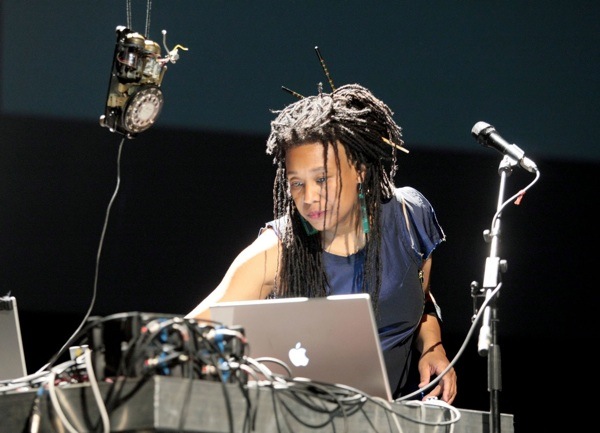
Singing the wild soul …
During the intermission to the closing concert of the summer 2011 Z Program’s Chamber Series, “Room: Poetry and Motion,” which was performed this past Friday, a fellow audience member told me a story of her workplace—not only had her publishing house instituted layoffs but it had also dropped the standard design fee for book covers to one-tenth of what it had been for nearly two decades. Her point was that in our currently cruel and heedless economy, it was a relief and a joy to see performers present art that was both deeply personal and artistically pleasing, rather than producing art produced by economic exigencies or the givens of institutional survival.
Since 2006, Pamela Z, the Bay Area’s maestra of electronic music and subversive vocal performance art, has been hosting an annual concert series at the lovely Royce Gallery on Mariposa Street in San Francisco. The Room Series specializes in presenting sonic performance that is edgy and casually idiosyncratic while maintaining a high level of technical innovation. Performance that also reveals the subtle acoustic beauties of our collective technological soul.
The “Poetry” in Friday’s concert’s title referred to short narrative works by Katt and Kenneth Atchley, Dean Santomieri, and Pamela Z, while the “Motion” referred to the three Butoh dancers—Kinji Hayashi, Leigh Evans dressed in disintegrating lingerie, and Shinichi Iova-Koga—who danced during the musicians’ compositions. While the first half of the program was composed prior to the performance, the second half depended on chance—the random mixture of dancer and musician—and improvisation.
The Atchleys describe their work as “a sonic cocktail of words and tones, commercially available (artistically modified) loops, custom distortion, and audio files from their private collection,” and it would be hard to give a more accurate description. The “commercially available” loops tend to give a predictably synthetic quality to their work, though Kenneth’s clarity of diction and tone anchors the sound into a personal reality. Their piece “NorCal” wanders the urban angst of the Bay Area, ending with the benign, though fatalistic, phrase: “I wouldn’t change a thing.”
Pamela Z’s “Flare Stains” was composed of layers of looping voice and sound fragments—including the crackling of crushed plastic wrapping—which she created on-stage. Over this densely tiered sound, she related occasional surrealist or charged images: “life’s spilled wooden matches,” “ballroom step dances,” “clippings from a giant’s haircut.” Her spontaneity and ease of delivery erased any pretension that might be read into the verbal fragments, and the result was fresh, whimsical and aurally pleasing.
Dean Santomieri alternated electronic guitar musings with the narrative of a chemically induced fantasy that traveled from the spinning white wasteland of Antarctica to springtime in Paris with all its erotic impulses.
Dancing the darkness …
How the Butoh dancers interacted with the musicians was a large component of program’s interest. Butoh is “a dangerous, subversive dance theater” that emerged in Japan in the 1960s, and is attributed to dancers Tatsumi Hijikata and Kazuo Ohno. Its practitioners, stripped down, shaven and painted white, often portray violent and sexually explicit imagery, full of anguish. Though none of the “Poetry and Motion” dancers dressed in characteristic Butoh manner, Kinji Hayashi and Leigh Evans each projected the despair, physical tension, constriction and anguish that are associated with Butoh: Hayashi using a Japanese movement vocabulary and Evans something closer to the mechanical doll movements of mime.
Shinichi Iova-Koga, who founded and heads the InkBoat dance collective currently in residence at ODC, gave the most impressive performance of the evening: emotionally wide ranging, and grounded in an ironic and absurdist humor, his collaborations with Dean Santomieri were brilliant in their changeability, lightning fast movement, and incisive reactive improvisation.
Description doesn’t really do justice to this event, so if you’re intrigued, keep an eye out for the next Z Performances Room series of innovative electronic chamber music. Information can be found at http://www.pamelaz.com/room.html. And for an available-now trip into the creative mind of Pamela Z, visit her online artwork at baggageallowance.tv.
—Jaime Robles
Photo courtesy of Ars Electronica
